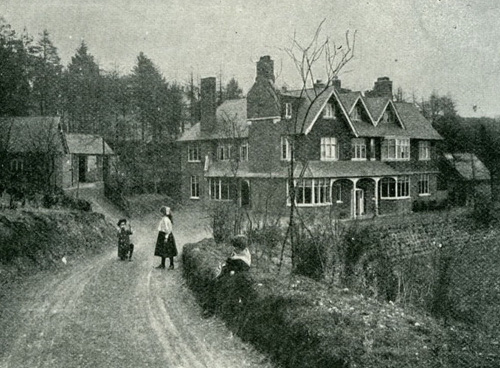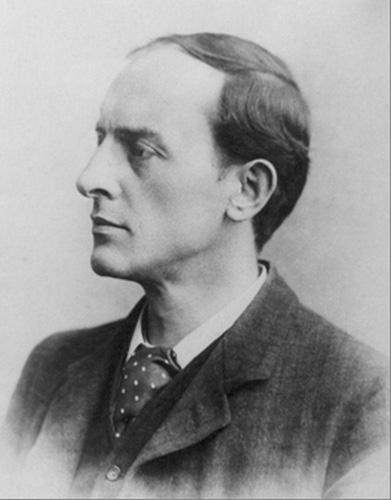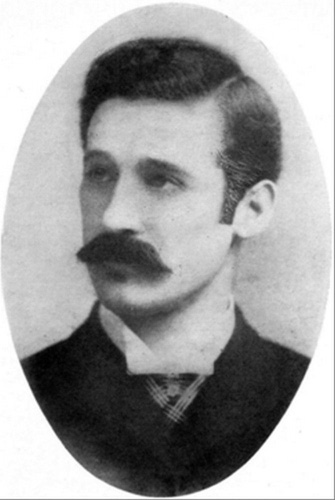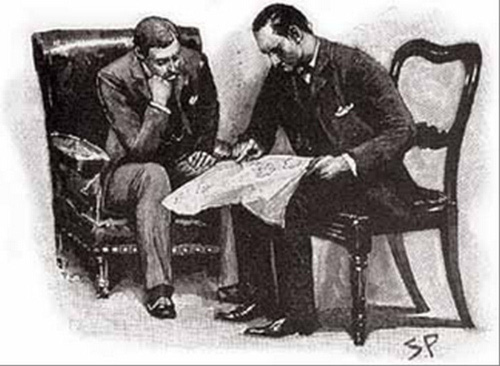The MX Book of New Sherlock Holmes Stories Part II (2 page)
Read The MX Book of New Sherlock Holmes Stories Part II Online
Authors: David Marcum
Tags: #Sherlock Holmes, #mystery, #crime, #british crime, #sherlock holmes novels, #sherlock holmes fiction, #sherlock holmes short fiction, #sherlock holmes collections
Part III:
With many sincere thanks...
Throughout the process, everyone that I've contacted about writing a story has been more than gracious, either by immediately stepping up and offering to provide one, or - when he or she couldn't join the party due to other obligations - continuing to offer support in numerous other ways. As the editor, being able to read these new adventures straight out of the Tin Dispatch Box is an experience not to be missed. Having never before tried to put together such a diverse Sherlock Holmes anthology, I must say that the whole thing has quickly become addictive, and I cannot promise not to do another one, although one of this size and scope, which was truly jumping into the deep water and
then
learning to swim, is unlikely.
Of all the people I'd like to thank, I must first express my gratitude as a whole to the authors - or “editors”, if you will - of these new adventures from the Great Watsonian Oversoul. You stepped up and provided some really great stories that didn't previously exist. You also put up with my reminders, nudges, and story suggestions when I had to don my Editing Deerstalker. Along the way, as I was able to read these fine stories, I also met some really nice new people.
More specifically, I'd like to thank the following:
My wife Rebecca and my son Dan
, who mean everything - and I mean
everything
! - to me. They constantly put up with my Sherlockian interest, my ever-increasing pastiche collection, and my tendency to wear a deerstalker as my only hat for three-quarters of the year.
Steve Emecz
, publisher extraordinaire and the hardest working man in show-biz. Thanks for the constant support and for always listening!
Bob Gibson
of
staunch.com
- an amazing graphic artist, who let me keep tinkering with the cover, which became two covers, and then three...
Joel and Carolyn Senter
. Years ago, my family knew to start my birthday and Christmas shopping with Joel and Carolyn's “Classic Specialties” catalogs. Later, when the original version of my first Holmes book was published, they enthusiastically got behind it and were responsible for selling almost every copy that was sold. They've encouraged me at every step, and I'm so glad that they could be a part of this anthology.
Roger Johnson
, who is so gracious when my random emails arrive with Holmesian ideas and questions. Visiting with him and his wife, Jean, during my Holmes Pilgrimage to England in 2013 was a high point of my trip. More recently, he located some wonderful pictures of Holmes and Watson for use in these books. In so many ways, I thank you!
Bob Byrne
, whom I first “met” by emailing him a question about Solar Pons - if you don't know who Solar Pons is, go find out! - and then we ended up becoming friends.
Derrick Belanger
, who hadn't specifically channeled Watson before, and is now on his way to becoming one of the best. Thanks for the friendship, the back-and-forth discussions upon occasion, and the support.
Marcia Wilson
, an incredible author and friend who received my first fan letter, long before I ever started thinking about writing anything myself. I've always said that, with her complex tales of Lestrade and his associates, she's found
Scotland Yard's
Tin Dispatch Box.
Denis O. Smith
, who was at the top of my pastiche wish list. I'm so glad that I was able to track him down, and I've really enjoyed the ongoing e-discussions we've had along the way since then;
Lyndsay Faye
, who said yes the very first day that I invited her to submit a story, and who also educated me about contracts.
Bert Coules
, for his advice and contributions, and for helping put together the Holmes and Watson that I hear in my head, Clive Merrison and Michael Williams.
Carole Nelson Douglas
, who - among many things - gave me some invaluable advice about foreign editions.
Les Klinger
, who spent part of a Sunday afternoon in a cross-country phone call, giving me some really valuable advice.
Otto Penzler
, who helped me several times when I pestered him for advice, and who wisely told me that “editing anthologies isn't quite as easy as drawing up a wish list and signing up stories”.
Chris Redmond
, who jumped in early, and for all that he does, and just for having that incredible website,
sherlockian.net
.
Kim Krisco
, whom I met (by email) along the way, and was a never-ending source of encouragement.
Tim Symonds
, also an email friend with a lot of great ideas and support. I look forward to catching up with you at Birling Gap someday.
John Hall
, whose books - both pastiches and scholarship - I've enjoyed for years.
Andy Lane
â Thanks for the clever back-and-forth emails. I'm sorry I couldn't make it to New York when you were over here. I'll catch you next time!
James Lovegrove
, who corresponded with me way-back-when about the
true
location of Holmes's retirement villa on the Sussex Downs. (You know where I mean.) I'm very jealous of where you live.
Steven Rothman
, editor of
The Baker Street Journal
, for always responding so nicely whenever one of my emails drops in from out of the blue.
Matthew Elliott
, for all that he's done, and also for helping with the description of what he's accomplishing at Imagination Theatre.
Maxim Jakubowski
, who introduced me to a great new set of people.
Mark Gagen
, who gave me permission to use that absolutely perfect picture of Holmes on the back cover.
And last but certainly
not
least,
Sir Arthur Conan Doyle
: Author, doctor, adventurer, and the Founder of the Feast. Present in spirit, and honored by all of us here.
This collection has been a labor of love by both the participants and myself. Everyone did their sincerest best to produce an anthology that truly represents why Holmes and Watson have been so popular for so long. This is just another tiny piece of the Great Holmes Tapestry, which will continue to grow and grow, for there can never be enough stories about the man whom Watson described as “the best and wisest... whom I have ever known.”
David Marcum
August 7
th
, 2015
163
rd
Birthday of Dr. John H. Watson
Questions or comments may be addressed to David Marcum at
[email protected]
Study and Natural Talent
by Roger Johnson
Greenhough Smith, editor of
The Strand Magazine
, hailed Arthur Conan Doyle as “the greatest natural storyteller of his age”. Over a century on, Conan Doyle's genius keeps us reading, and, because many of us feel that sixty adventures of Sherlock Holmes just aren't enough, we write as well. The original tales are exciting and often ingenious; they're intelligent without being patronising, and they're never pretentious. The characters of Holmes and Watson - the apparently contrary forces that actually complement each other like Yin and Yang - stimulate our imaginations. Surely every devotee believes that the world needs more stories of Sherlock Holmes, and as, barring a true miracle, there'll be no more from his creator's fondly wielded Parker Duofold pen, we should provide at least one or two ourselves. We know the originals inside-out, or we think we do; we have a grand idea for a plot, and the style seems to be - well - elementary. How hard can it be?
In fact it's a sight harder than most of us think. Believe me: I know! To set a story convincingly in late Victorian or Edwardian London can require a fair deal of research just to avoid simple anachronisms and similar errors of fact. There are aspects of personality that may need careful attention - not just Holmes and Watson, but other established characters such as Messrs Lestrade and Gregson, and Mrs. Hudson (who really
was
the landlady at 221B, and
not
the housekeeper). Vocabulary and speech-patterns are important...
Some will say, of course, that it's impossible to replicate the Doyle-Watson style. Nevertheless, there are writers who have come acceptably close to the real thing. Edgar W. Smith declared that
The Exploits of Sherlock Holmes
by Adrian Conan Doyle and John Dickson Carr should be re-titled
Sherlock Holmes Exploited
, but it is actually a remarkably good collection. Nicholas Meyer, L. B. Greenwood, Barrie Roberts, and Michael Hardwick are other names that come to mind, of authors who have, as Holmes himself said in a different context, applied both study and natural talent to the writing of new Sherlock Holmes adventures. For the current monumental collection, conceived and published for the benefit of the house that saw the rebirth of the great detective, David Marcum has coaxed stories from the best of today's generation of Holmesian chroniclers. Some of the contributors are famous, and some perhaps are destined for fame, but all of them bring intelligence, knowledge, understanding and deep affection to the task - and we are the gainers.
Roger Johnson, BSI, ASH
Editor:
The Sherlock Holmes Journal
August 2015
Foreword
by Catherine Cooke
It all depends on your point of view. Fifty-six short stories and four long stories. Sixty cases of Sherlock Holmes spanning forty years. Sir Arthur Conan Doyle thought that was quite enough - probably too many even. While some commentators have opined that not all reach the same high standards, it cannot be denied that for the legions of Holmes's students, 60 is not nearly enough. They beg,
desire
,
DEMAND
more.
Sir Arthur was a man of action. His wife Touie was diagnosed with tuberculosis. He took her abroad to climes more suited - to Switzerland and Egypt. Hearing from a friend about “Little Switzerland”, an area of Hampshire considered to have a climate as beneficial, he rushed down to Hindhead, bought a plot of land, and had a house built, specially designed for himself and for his ailing wife: shallow stairs, easy to open doors, and a couple of splendid heraldic windows. It is a tragedy of recent years that this house, Undershaw, and its beautiful grounds have been allow to fall into rack and ruin while legal disputes rumbled on.
But now there is cause for rejoicing on both fronts. A collection in three volumes (count âem,
three
) of new Sherlock Holmes stories from well-practiced, well-known pens, as well as from newer writers - surely here there is something for all tastes. Furthermore, all royalties are to go to projects in the redevelopment of Undershaw by Stepping Stones. Conan Doyle's house will rise again offering specialist educational facilities to enable its students to achieve their full potential.
Congratulations are due to the editor, David Marcum, to MX Publishing, and to all those writers and supporters who have given their time, talents, and money to make these volumes possible. Now settle back and enjoy new accounts from the classic years of Holmes and Watson's partnership, which may shed new light on the mysterious years of the Great Hiatus.
Catherine Cooke, BSI, ASH
August 2015

Undershaw
Circa 1900
(Source: Wikipedia)
Undershaw: An Ongoing Legacy for Sherlock Holmes
by Steve Emecz
The authors involved in this anthology are donating their royalties toward the restoration of Sir Arthur Conan Doyle's former home, Undershaw. This building was initially in terrible disrepair, and was saved from destruction by the
Undershaw Preservation Trust
(Patron: Mark Gatiss). Today, the building has been bought by Stepping Stones (a school for children with learning difficulties), and is being restored to its former glory.
Undershaw is where Sir Arthur Conan Doyle wrote many of the Sherlock Holmes stories, including
The Hound of The Baskervilles
. It's where Conan Doyle brought Sherlock Holmes back to life. This project will contribute to specific projects at the house, such as the restoration of Doyle's study, and will be opened up to fans outside term time.
You can find out more information about the new Stepping Stones school at
www.steppingstones.org.uk

Sherlock Holmes
(1854-1957) was born in Yorkshire, England, on 6 January, 1854. In the mid-1870's, he moved to 24 Montague Street, London, where he established himself as the world's first Consulting Detective. After meeting Dr. John H. Watson in early 1881, he and Watson moved to rooms at 221b Baker Street, where his reputation as the world's greatest detective grew for several decades. He was presumed to have died battling noted criminal Professor James Moriarty on 4 May, 1891, but he returned to London on 5 April, 1894, resuming his consulting practice in Baker Street. Retiring to the Sussex coast near Beachy Head in October 1903, he continued to be involved in various private and government investigations while giving the impression of being a reclusive apiarist. He was very involved in the events encompassing World War I, and to a lesser degree those of World War II. He passed away peacefully upon the cliffs above his Sussex home on his 103
rd
birthday, 6 January, 1957.

Dr. John Hamish Watson
(1852-1929) was born in Stranraer, Scotland on 7 August, 1852. In 1878, he took his Doctor of Medicine Degree from the University of London, and later joined the army as a surgeon. Wounded at the Battle of Maiwand in Afghanistan (27 July, 1880), he returned to London late that same year. On New Year's Day, 1881, he was introduced to Sherlock Holmes in the chemical laboratory at Barts. Agreeing to share rooms with Holmes in Baker Street, Watson became invaluable to Holmes's consulting detective practice. Watson was married and widowed three times, and from the late 1880's onward, in addition to his participation in Holmes's investigations and his medical practice, he chronicled Holmes's adventures, with the assistance of a literary agent, Sir Arthur Conan Doyle, in a series of popular narratives, most of which were first published in
The Strand
magazine. Watson's later years were spent preparing a vast number of his notes of Holmes's cases for future publication. Following a final important investigation with Holmes, Watson contracted pneumonia and passed away on 24 July, 1929.
Photos of Sherlock Holmes and Dr. John H. Watson courtesy of Roger Johnson
PART II: 1890-1895

The years between 1890 and 1895 were times of upheaval for both Holmes and Watson. While Watson continued to enjoy married life with his wife, Mary, Holmes faced an ever escalating battle with the Napoleon of Crime, Professor James Moriarty. The contest between the two culminated on 4 May, 1891, atop the Reichenbach Falls. While Watson was decoyed away, Holmes and Moriarty met and fought on the slippery ledge. Moriarty fell, and Holmes did not. However, seeing the opportunity to continue his work in secret if he was thought to have died, and also as a way to protect Watson and his wife from the last remains of the Professor's organization, Holmes allowed Watson to believe that he, too, had fallen. Watson returned home heartbroken, while Holmes journeyed all over the world, carrying out missions for the British Government and his brother, Mycroft. From May 1891 until April 1894, Holmes traveled to various locations, including Lhasa in Tibet, Mecca, Khartoum, and Montpellier, France (as recorded in
“The Empty House”.
) In addition, he also visited many other locations that are not recorded in the Canon.
While Holmes was away from England, Watson faced both the grief of losing his best friend, as well as the death of his wife Mary in 1893. When Holmes returned to London in April 1894, Watson was amazed to learn that his friend was alive after all, and he soon returned to sharing rooms at 221b Baker Street. The years that followed, particularly 1894-1895, were extremely busy, and the cases literally tumbled upon them, one after the other...
.